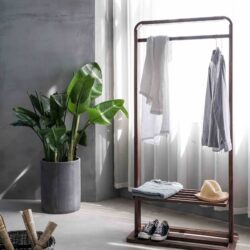Embracing Nature at Home: The Beauty of Biophilic Design
Introduction: In a world characterized by concrete jungles and bustling city life, the desire to reconnect with nature is a universal yearning. Biophilic design, a concept rooted in the innate human connection with the natural world, brings the outdoors into our living spaces. By incorporating elements inspired by nature, this design philosophy seeks to enhance well-being, reduce stress, and create harmonious environments. Let’s explore the beauty and benefits of biophilic design for a nature-inspired home.
- Bringing the Outdoors In: At the core of biophilic design is the idea of integrating natural elements into interior spaces. This can include large windows that frame outdoor views, indoor plants, natural materials like wood and stone, and even artwork depicting nature scenes. By blurring the lines between indoor and outdoor spaces, biophilic design creates a seamless connection to the natural world.
- Abundant Natural Light: Maximizing natural light is a fundamental aspect of biophilic design. Large windows, skylights, and glass doors allow sunlight to flood the space, creating a bright and uplifting atmosphere. Natural light not only enhances the visual appeal of a home but also positively impacts mood and circadian rhythms.
- Greenery Everywhere: Houseplants are not just decorative accents; they are integral to biophilic design. Whether it’s a towering fiddle leaf fig in the living room or a collection of succulents in the kitchen, indoor plants bring a sense of vitality and freshness to the home. Consider creating a dedicated green corner or incorporating hanging planters for a vertical garden effect.
- Natural Materials and Textures: Embrace the warmth and authenticity of natural materials. Wood, stone, bamboo, and jute are examples of materials that can be used in furniture, flooring, and decor to evoke the textures found in nature. The tactile experience of these materials adds a layer of comfort and connection to the environment.
- Water Features: The sound of flowing water can be incredibly soothing. Incorporating water features, such as tabletop fountains or indoor ponds, introduces an auditory element of nature into your home. The gentle sound of water contributes to a tranquil and relaxing atmosphere.
- Biophilic Color Palette: Choose a color palette inspired by nature. Earthy tones like greens, browns, and blues create a calming and grounding effect. These colors not only reflect the beauty of the outdoors but also evoke a sense of serenity and balance within your living space.
- Natural Shapes and Patterns: Look for furniture and decor that feature organic shapes and patterns. The irregular curves of natural forms, such as leaves or stones, can be replicated in design elements like rugs, cushions, and artwork. This mimicking of nature’s patterns creates a visually pleasing and cohesive aesthetic.
- Views and Prospect: Consider the layout of your home to optimize views of the surrounding landscape. If possible, position seating areas or workspaces near windows with scenic views. This design principle, known as prospect, allows inhabitants to visually connect with the outdoor environment, fostering a sense of calm and well-being.
- Biophilic Art and Photography: Adorn your walls with artwork that celebrates the beauty of nature. Photographs of landscapes, botanical illustrations, or paintings inspired by the natural world can serve as visual reminders of the outdoors. Choose pieces that resonate with you personally and bring a touch of the outside in.
- Flexible and Open Spaces: Create open and flexible spaces that allow for a greater sense of freedom and movement. Biophilic design encourages a flow between rooms and a connection to the natural elements throughout the home. Consider open floor plans that facilitate the movement of air and light, enhancing the overall well-being of the inhabitants.
Conclusion: Biophilic design is not merely an aesthetic trend; it is a holistic approach to creating living spaces that nurture the human spirit and enhance our connection to the natural world. By incorporating elements inspired by nature, whether through greenery, natural materials, or abundant natural light, biophilic design transforms homes into sanctuaries of well-being. As we strive for balance in our busy lives, bringing the essence of nature into our living spaces becomes not only an aesthetic choice but a commitment to creating environments that promote health, happiness, and harmony.
Certainly! Here’s a set of frequently asked questions (FAQ) related to biophilic design for a nature-inspired home:
Q1: What is biophilic design? A1: Biophilic design is an approach to architecture and interior design that seeks to connect people with nature by incorporating natural elements, materials, and patterns into the built environment. It aims to create spaces that enhance well-being and foster a connection to the natural world.
Q2: How does biophilic design benefit home environments? A2: Biophilic design has been shown to improve mental well-being, reduce stress, and increase productivity. In home environments, it creates a more harmonious and calming atmosphere by bringing nature indoors.
Q3: What are some key elements of biophilic design for homes? A3: Key elements include the use of natural materials (wood, stone), large windows for natural light, indoor plants, nature-inspired artwork, water features, and views of greenery. These elements help create a connection to nature within the home.
Q4: Can biophilic design be applied to any style of home? A4: Yes, biophilic design principles can be incorporated into various architectural styles, from modern to traditional. It’s about integrating natural elements and patterns in a way that complements the overall design aesthetic of the home.
Q5: How can I bring more natural light into my home with biophilic design? A5: Maximize natural light by using large windows, skylights, and glass doors. Arrange furniture to allow the flow of light, and use light-colored or reflective surfaces to enhance the brightness of the space.
Q6: Are indoor plants a crucial element of biophilic design? A6: Yes, indoor plants play a significant role in biophilic design. They not only bring nature indoors but also improve air quality and contribute to a sense of well-being. Choose a variety of plants to create a diverse and natural feel.
Q7: How can I incorporate natural materials in biophilic design? A7: Use materials like wood, stone, bamboo, and cork in your home. Integrate these materials into flooring, furniture, and decor elements. The presence of natural textures enhances the overall biophilic atmosphere.
Q8: Can biophilic design be applied to small living spaces? A8: Yes, biophilic design can be adapted to small living spaces. Consider vertical gardens, potted plants, and nature-inspired artwork. Even small touches like natural materials and textures can have a positive impact.
Q9: Are there specific color palettes that enhance biophilic design? A9: Natural and earthy color palettes, including greens, browns, and blues, are often associated with biophilic design. These colors mimic those found in nature and contribute to a calming and soothing atmosphere.
Q10: Can water features be incorporated into biophilic design for homes? A10: Yes, water features like indoor fountains or aquariums can be incorporated into biophilic design. The sound of flowing water and the visual presence of water elements contribute to a tranquil and nature-inspired ambiance in the home.
In conclusion, biophilic design emerges as a transformative and holistic approach, seamlessly integrating the natural world into the fabric of our living spaces. Rooted in our innate connection to nature, this design philosophy seeks to enhance well-being, foster tranquility, and promote a sense of harmony within the home environment. By incorporating elements such as natural materials, greenery, and abundant natural light, biophilic design not only brings the outdoors inside but also creates a sanctuary that nurtures the mind, body, and spirit.
The use of natural materials, such as wood, stone, and plant fibers, serves as a cornerstone of biophilic design. These materials not only add warmth and texture to the home but also connect inhabitants to the Earth’s natural elements. The incorporation of wooden furniture, stone accents, and sustainable materials reinforces a sense of authenticity, grounding the home in a visual and tactile celebration of nature.
Indoor plants play a pivotal role in biophilic design, introducing a dynamic and living element to the home. Beyond their aesthetic appeal, plants contribute to improved air quality and evoke a sense of vitality. Strategically placing greenery throughout the home fosters a connection with nature, creating a serene and refreshing atmosphere that enhances overall well-being.
Ample natural light is a fundamental aspect of biophilic design, illuminating living spaces and fostering a connection to the rhythms of the natural world. Large windows, skylights, and open floor plans maximize exposure to natural light, creating a bright and uplifting ambiance. This emphasis on daylight not only reduces reliance on artificial lighting but also promotes a sense of openness and connectivity with the outdoor environment.
Biophilic design extends beyond the visual to engage the senses through sounds, scents, and even the patterning of natural elements. The introduction of flowing water features, the use of natural scents, and the incorporation of organic patterns in design elements contribute to a multisensory experience, further immersing inhabitants in a nature-inspired home.
In our fast-paced, technology-driven world, biophilic design serves as a counterbalance, offering a respite and an antidote to the stresses of modern life. It transforms the home into a haven, where the healing and restorative powers of nature are woven seamlessly into the very fabric of our living spaces. In embracing biophilic design, individuals not only create aesthetically pleasing homes but also cultivate environments that support their well-being and foster a deep and enduring connection to the natural world.
















